Several weeks ago, I read an article in the Austin Chronicle talking about a day trip to Coleman and stopping in at the Owl Drug Store there, which is an old-style drugstore with soda fountain like the Service Drug of my childhood. I thought it would be fun to show this to Alyks, and put it on a list of things to do for a day trip at some point. L decided that the Monday of Memorial Day weekend would be a good time for the two of us to go, because she wanted to make a mess in the house while re-organizing things and not have to worry about annoying the two of us with the mess. I decided the idea had some merit, but didn’t bother to check to see whether the drugstore would be open on the holiday. (That was a mistake.)
Monday morning Alyks and I got up and went out for breakfast, then went back to the house to pick up a few essential things we forgot like a camera, and finally started out in the middle of a rainstorm. To get to Coleman, you go north on US Highway 183 to Brownwood, then turn left on US 84. 183 turned out to be no fun in the rain; between the worn road surface and Quinn’s worn tires, she was hydroplaning every mile or two and I fought her continuously. (It’s past time for a new set of tires.) Fortunately, the rain let up and went away before we reached Lampasas, the road dried out and driving got a lot less nerve-wracking.
For the entertainment value of it, we turned off in Brownwood to hunt up the 1912 courthouse for Alyks to add to his courthouse collection. When we got there, he agreed that my recollected impression of it as looking like a brown-brick school was an accurate one and that it was completely boring. (Wasn’t even worth taking a picture of. That’s how boring.) I did stop for long enough to read the state hysterical marker describing who the Mr. Brown was for whom Brownwood is named (he was a rancher who donated the town site).
Box ticked off on the courthouse list, we got onto Highway 84 and headed west. We ran through Bangs and Santa Anna, where my grandfather once owned a movie theater. Neither has more than a thousand people in it; more Texas towns dying by inches on the vine.
Coleman, when we got to it, was bigger (4,500 people) but no more lively. Having gambled on holiday activity, I found I’d rolled snake eyes. The entire downtown was shut up tight as a drum, including the drugstore we had come to visit. Rats.
Since we couldn’t do what we came for, we stopped at the courthouse to look at the monuments on the lawn. They had several, the best of which was the bell from the original 1884 courthouse. Later I looked up the bell founder, Henry McShane, and discovered the foundry is still in business though not in the same location. I had a momentary thought of whacking the bell with a mallet to see how it sounded, but then remembered I didn’t have a mallet.
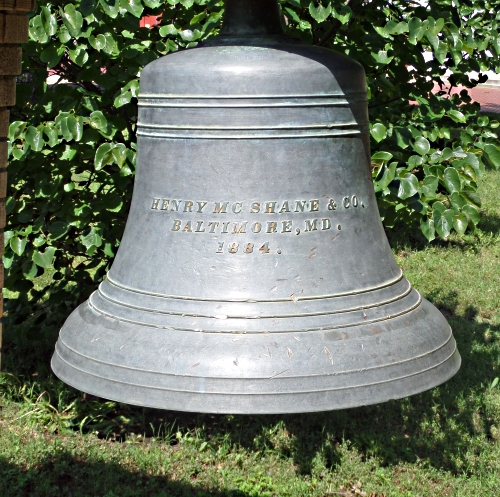
Next to the bell was a bronze tablet commemorating the Western cattle trail of the 1880s and 90s, put up by the D. A. R. A pink granite bench was covered in cattle brands, which I guessed belonged to early settlers of the county.
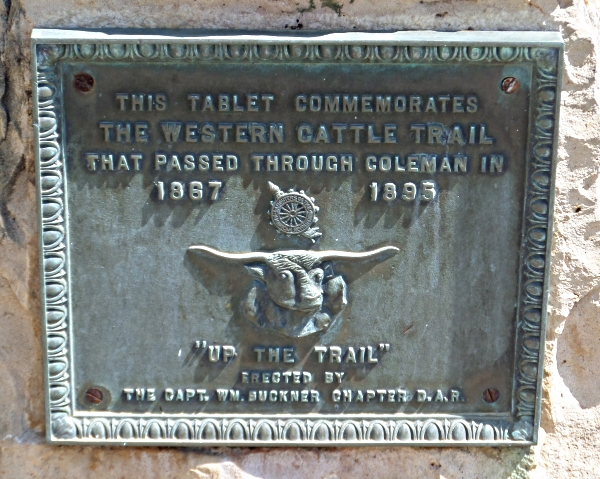
The courthouse itself was even more boring than the one at Brownwood; Alyks said that it looked like his elementary school and I can’t disagree. The cornerstone (really more of a plaque) gave a construction date of 1952, which I would totally believe. It was just about that ugly.
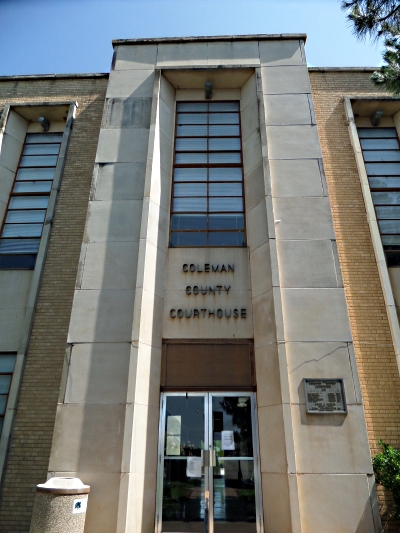
That about exhausted the minimal charms of the courthouse, so we got back in the car and started driving around to see what there was to see downtown. A few blocks away, we came across an excellently restored Sinclair station, something that I might have seen myself when I was young. It had a fine pair of replica Erie 700 series pumps, or possibly even the repainted originals. (Things don’t get thrown away in the country as much. You just stick it out behind the barn in case somebody might need it.) The free air and mechanic signs, however, are pretty certainly replica. No original would look that good after 75 years. The same goes for the neon clock inside the station office, which I had to take a picture of through the door since it was all locked up.
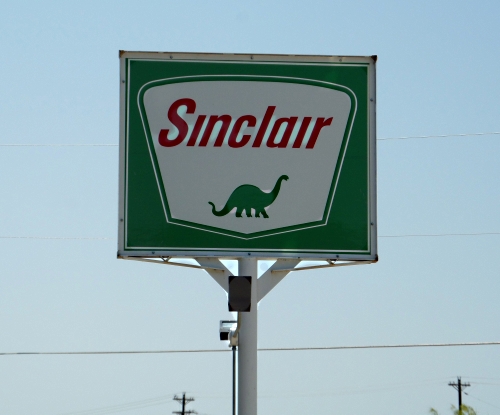
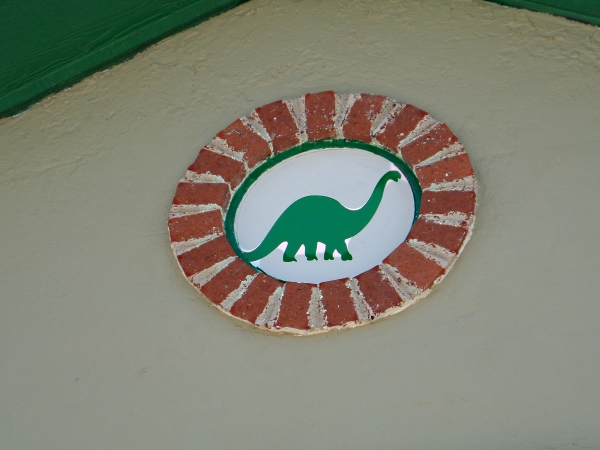
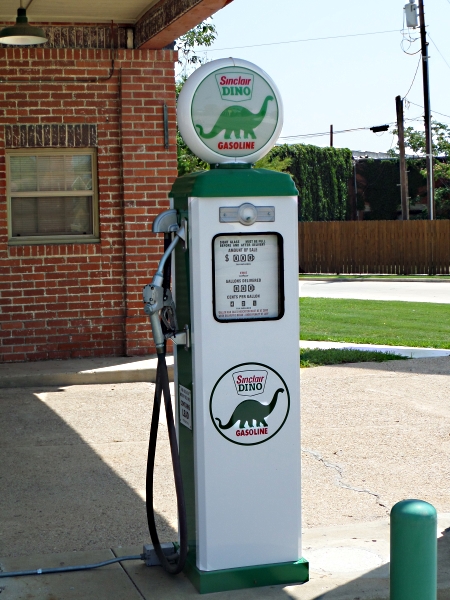
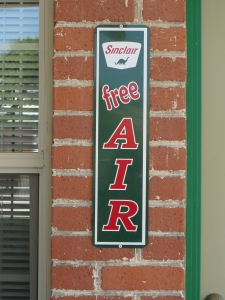
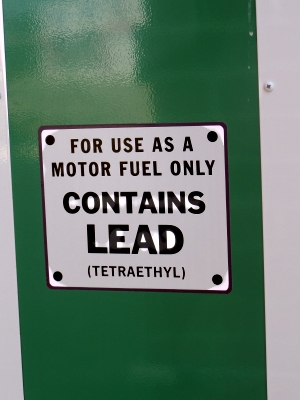
It happened that the owner was there mowing the grass, and came over to talk to us for a few minutes. I complimented him on how well he had done the work, which seemed to please him.
There were a number of commercial signs painted on buildings around downtown, both ghosts of originals and complete repaints. Repaints included the Piggly Wiggly (or as I used to call it in my childhood, the “Wiggle Piggle”) and the steam laundry and dry cleaner; the Odd Fellows lodge included not only a ghost of the lodge’s name, but a palimpsest of a Coke advertisement overlaid with a furniture company sign.
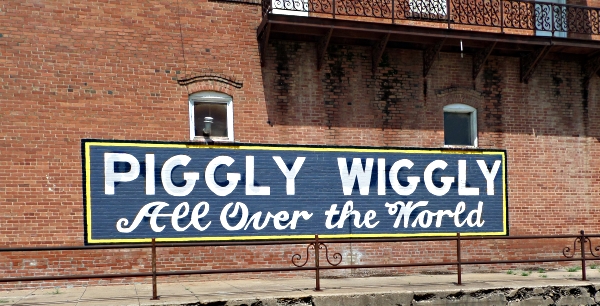
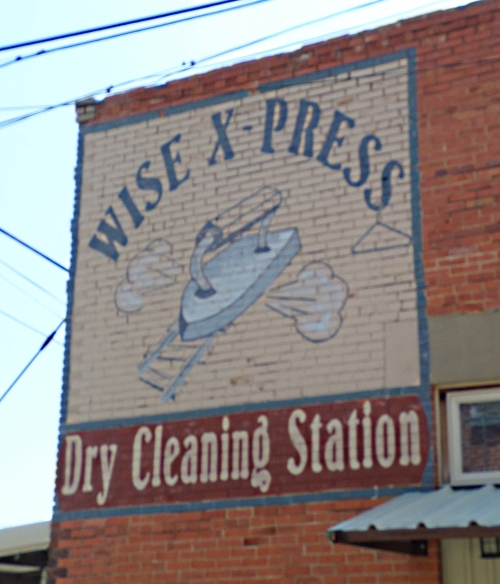
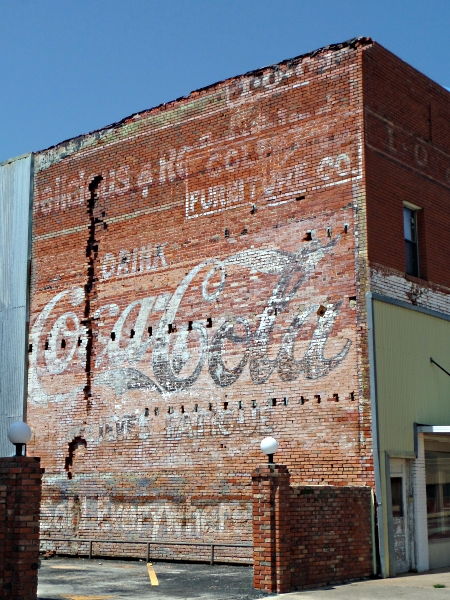
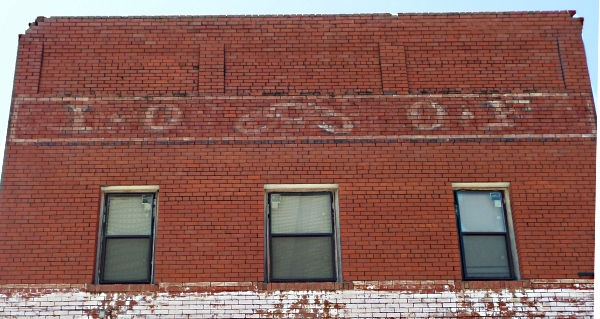
I caught a glimpse of the county jail behind the courthouse which, unlike the courthouse itself, was actually a nearly original structure; it was built in 1890 and replaced a rickety 1879 structure. Unfortunately between the razor wire and fencing surrounding the exercise yard and the trees, I didn’t get a very good shot of the building although it certainly looks like it would be worthy. Older photos make it look a little bit like a school, as long as you ignore the barred windows. (Come to think of it, maybe you don’t have to ignore the bars ….)
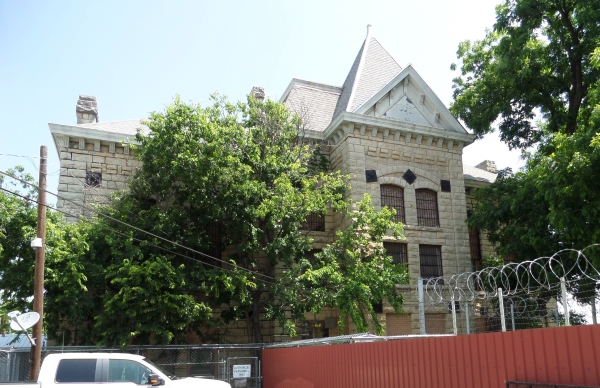
Also hiding behind the courthouse was a very typical 1920s Commercial Style building, brick with Sullivanesque decorations around the parapet. Some philistine in the 1980s covered over the front with sheet metal, but fortunately left the side alone so we have an idea of what the whole building looked like originally.
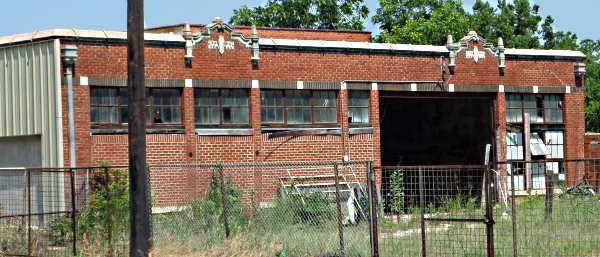
More local cattle brands appeared on the side of the Chamber of Commerce building, several dozens of them. (I wonder whether anybody has documented who they all belonged to, the way my mother did for Comanche County.) The last thing we admired was the post office, built in 1931 and in fine shape. By that point I had figured out that the only place to get anything to eat in Coleman this day was at the 7-Eleven on the highway, and that didn’t really appeal. Alyks said he had a yen for a good hamburger, so we turned around and went back to Brownwood to look for one.
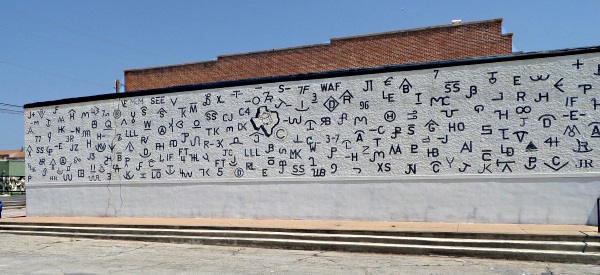
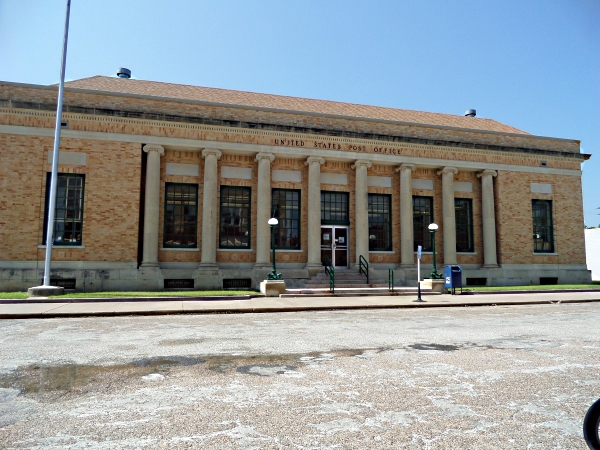
I’ve been gone from the area too long and don’t know where the good places are to eat any more (except not at Underwood’s Cafeteria, unless you want fried chicken and peach cobbler, and we didn’t), so I decided to try driving toward Howard Payne University on the theory that there are eateries around any college. We didn’t find any on the main stem, so I gave up and went back past Dugout Doug’s (the Douglas MacArthur Academy of Freedom to outsiders) and over the railroad overpass, where I got a glimpse of what looked like a restored train station.
Something there is about me that can’t ignore a train station, especially when it looks like someone is taking care of it. So I turned off in that direction, and a couple of blocks of following my nose brought me to the station which was indeed very well restored, with a Santa Fe passenger locomotive on static display in a small park out front. We got out and I took some some pictures, then stopped to read the historical markers on the buildings. I was surprised and delighted to discover that one of the two buildings was an original Harvey House hotel, beautifully restored! In my enthusiasm, I ignored fences and warning signs and squeezed myself out onto the right-of-way to get pictures of the train side of the building. (Alyks said “I’m gonna leave you to that” and stayed behind, in case I ran into a railroad bull and needed to get bailed out of jail for trespassing.)
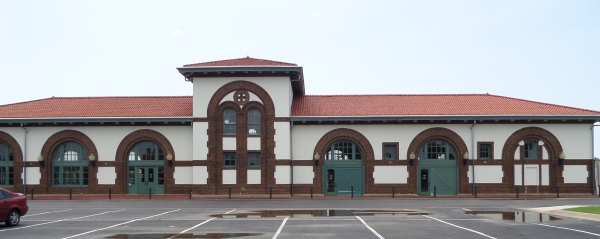
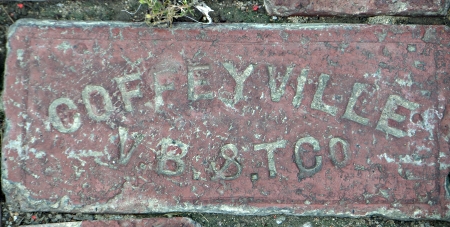
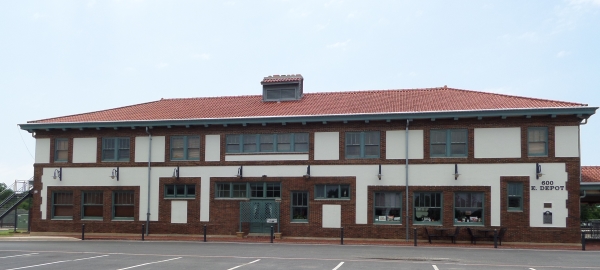
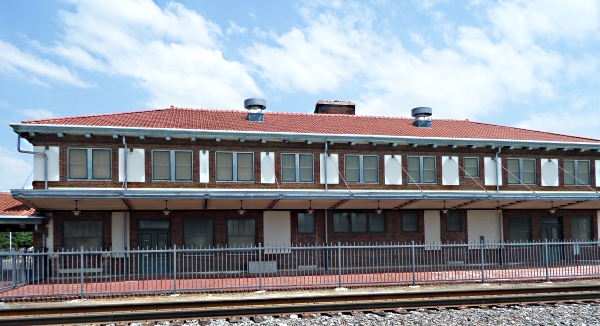
Again, everything was closed tight because of the holiday but I went and peered through all the windows, and could see enough to know that I want to come back on a day when they’re open. (I’ve since discovered that they have one of the waitresses’ dormitory rooms preserved as it would have been about 1920.)
The Santa Fe locomotive, a 2-6-2 Prairie type, is in overall okay condition, though showing some rust pox on the boiler jacket and smoke box door, which was distressing. Also, all the glass in the lamps was broken as is so common with static outdoor displays, and one of the running lamps was completely missing. Damn the vandals, anyway.
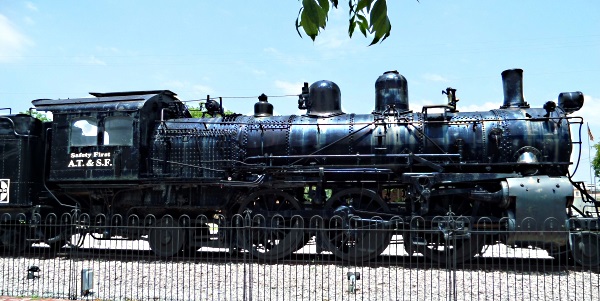
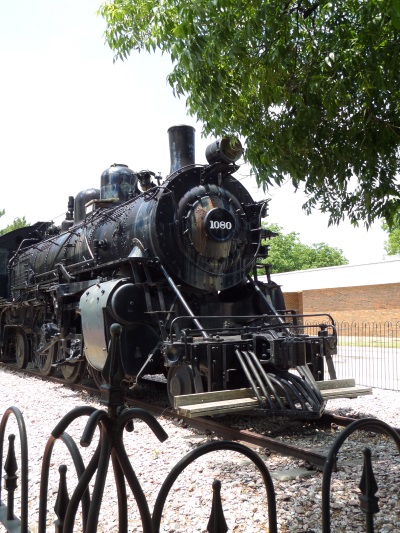
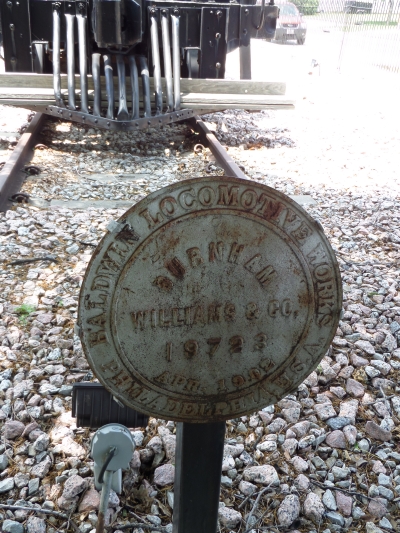
Alyks was patient with my enthusiasm, but still we were both hungry so eventually I surrendered and, after a trip around what I thought might be the old Andrew Carnegie library building (it wasn’t; that building was demolished in 1965) we went back out to the highway and stopped at Chili’s. This solved the issue of burgers, but some kind of crisis in the kitchen meant that our order was badly delayed. Without asking, the server brought us chips and salsa as an appeasement but I still counted points off against the kitchen (and not the server) on the customer survey at the end.
We came home SORTA the way we had come, down 183 through Zephyr where I stopped to take more ghost-sign photos at an old general store, but at Goldthwaite I took a wild hair and turned off onto Texas 16 for San Saba, the “Pecan Capital of the World,” and somewhere I had never been, I don’t quite know why. We stopped for pictures of the pretty 1911 Texas Renaissance style courthouse (another box ticked for Alyks) and a quick swing around downtown, then ran across US 190 to pick up 183 again at Lometa and come home.
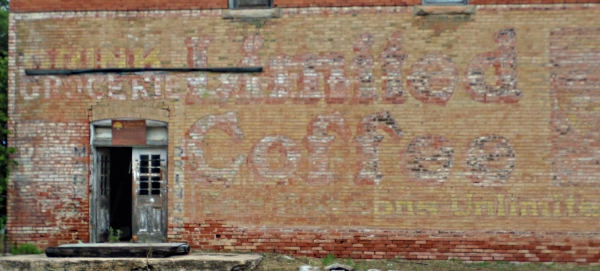
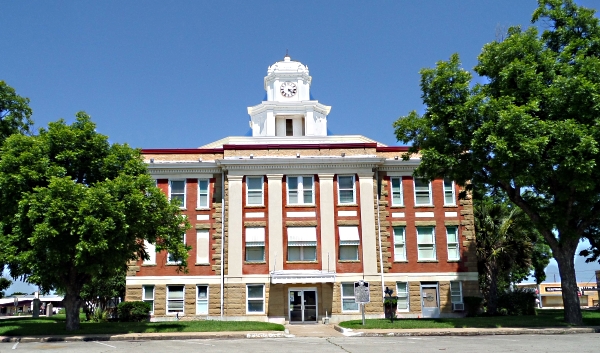
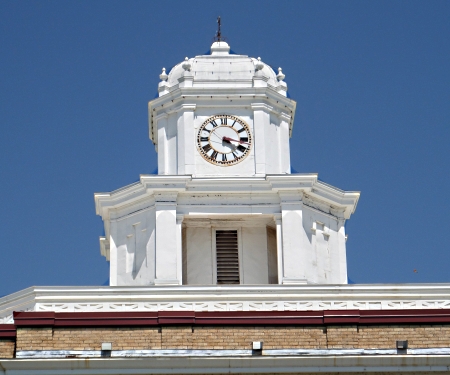
A man walking is cut in half by the window. Fnord.

One Response to Day Trips: Visit to a Coleman drug store that was closed